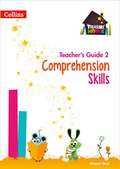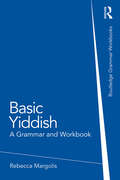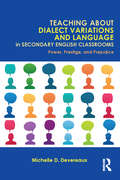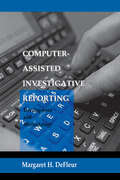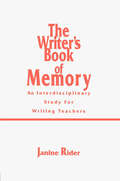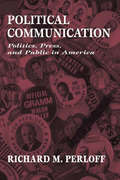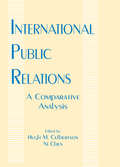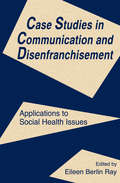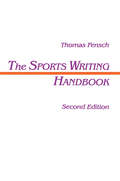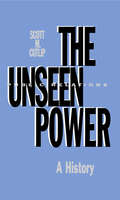- Table View
- List View
Comprehension Skills Teacher’s Guide 2 (Treasure House) (PDF)
by Abigail SteelTreasure House Comprehension Skills Teacher's Guides provide at-a-glance lesson planning to guide teachers through the activities in Treasure House Comprehension Skills Pupil Books. Treasure House Comprehension Skills Teacher's Guide 2: - provides at-a-glance planning with overviews, step-by-step instructions and answer keys for all Pupil Book units - offers ideas to enable all children to access learning in Support, Embed and Challenge sections - targets individual learning needs with photocopiable resources - maps units to the 2014 National Curriculum for English
Concepts in Composition: Theory and Practice in the Teaching of Writing
by Irene L. ClarkConcepts in Composition: Theory and Practice in the Teaching of Writing is designed to foster reflection on how theory impacts practice, enabling prospective teachers to develop their own comprehensive and coherent conception of what writing is or should be and to consider how people learn to write. This approach allows readers to assume the dual role of both teacher and student as they enter the conversation of the discipline and become familiar with some of the critical issues. New to this second edition are: up-to-date primary source readings; a focus on collaborative writing practices and collaborative learning; additional assignments and classroom activities an emphasis on new media and information literacy and their impact on the teaching of writing These new directions will inform the content of this revision, reflecting significant advancements in the field. Each chapter addresses a particular theoretical concept relevant to classroom teaching and includes activities to help readers establish the connection between theoretical concepts and classroom lessons. Online resources include overviews, classroom handouts, exercises, a sample syllabus, and PowerPoint presentations. Bringing together scholars with expertise in particular areas of composition, this text will serve as an effective primer for students and eductors in the field of composition theory.
Basic Yiddish: A Grammar and Workbook
by Rebecca MargolisBasic Yiddish: A Grammar and Workbook comprises an accessible reference grammar with related exercises in a single volume. The workbook is structured around 36 short units, each presenting relevant grammar points which are explained using multiple examples in jargon-free language. Basic Yiddish is suitable for both class use as well as independent study. Key features include: a clear, accessible format many useful language examples jargon-free explanations of grammar abundant exercises with a full answer key Clearly presented and user-friendly, Basic Yiddish provides readers with the essential tools to express themselves in a wide variety of situations, making it an ideal grammar reference and practice resource for both beginners and students with some knowledge of the language.
Living Languages: An Integrated Approach to Teaching Foreign Languages in Primary Schools
by Catherine Watts Clare Forder Hilary PhillipsLiving Languages is simply bursting with practical and original ideas aimed at teachers and trainee teachers of foreign languages in primary schools. Written by a team of experienced linguists, this book will inspire and motivate the foreign language classroom and the teachers who work within it. Living Languages comprises eight chapters and is structured around the integrated classroom, merging language learning with different aspects of the wider curriculum such as multimedia, performance, celebrations and festivals, creativity and alternative approaches to teaching languages. A DVD is also included with the book containing additional teaching materials and the associated films and audio recordings which make this a fully-developed and effective teaching resource. Over 50 real-life case studies and projects are presented, all of which have been tried and tested in the classroom with several having won recent educational awards. Ideas and activities outlined in this unique resource include: Languages across the curriculum helping to cement cross-curricular links and embed new languages in different contexts linking subjects such as history, science, PE and mathematics with French, German and Spanish; Arts and crafts projects in Languages, making and doing, including making books, creating beach huts and cooking biscuits; Languages, celebrations and festivals projects including the German Christmas market, Spanish Day of the Dead, celebrating Mardi Gras and the European Day of Languages among many others; Continuing Professional Development to inspire primary teachers to continue their individual professional development. The chapter contains concrete examples of others’ experiences in this area and includes details of support organisations and practical opportunities. Each project is explored from the teachers’ perspective with practical tips, lesson plans and reflections woven throughout the text such as what to budget, how to organise the pre-event period, how to evaluate the activity and whom to contact for further advice in each case. Activities and examples throughout are given in three languages – French, German and Spanish.
Teaching About Dialect Variations and Language in Secondary English Classrooms: Power, Prestige, and Prejudice
by Michelle D. DevereauxStandardized tests demand Standard English, but secondary students (grades 6-12) come to school speaking a variety of dialects and languages, thus creating a conflict between students’ language of nurture and the expectations of school. The purpose of this text is twofold: to explain and illustrate how language varieties function in the classroom and in students’ lives and to detail linguistically informed instructional strategies. Through anecdotes from the classroom, lesson plans, and accessible narrative, it introduces theory and clearly builds the bridge to daily classroom practices that respect students’ language varieties and use those varieties as strengths upon which secondary English teachers can build. The book explains how to teach about language variations and ideologies in the classroom; uses typically taught texts as models for exploring how power, society, and identity interact with language, literature, and students’ lives; connects the Common Core State Standards to the concepts presented; and offers strategies to teach the sense and structure of Standard English and other language variations, so that all students may add Standard English to their linguistic toolboxes.
Teaching About Dialect Variations and Language in Secondary English Classrooms: Power, Prestige, and Prejudice
by Michelle D. DevereauxStandardized tests demand Standard English, but secondary students (grades 6-12) come to school speaking a variety of dialects and languages, thus creating a conflict between students’ language of nurture and the expectations of school. The purpose of this text is twofold: to explain and illustrate how language varieties function in the classroom and in students’ lives and to detail linguistically informed instructional strategies. Through anecdotes from the classroom, lesson plans, and accessible narrative, it introduces theory and clearly builds the bridge to daily classroom practices that respect students’ language varieties and use those varieties as strengths upon which secondary English teachers can build. The book explains how to teach about language variations and ideologies in the classroom; uses typically taught texts as models for exploring how power, society, and identity interact with language, literature, and students’ lives; connects the Common Core State Standards to the concepts presented; and offers strategies to teach the sense and structure of Standard English and other language variations, so that all students may add Standard English to their linguistic toolboxes.
Public Journalism and Public Life: Why Telling the News Is Not Enough
by Davis Buzz" MerrittThe original edition of Public Journalism and Public Life, published in 1995, was the first comprehensive argument in favor of public journalism. Designed to focus the discussion about public journalism both within and outside the profession, the book has accomplished its purpose. In the ensuing years, the debate has continued; dozens of newspapers and thousands of journalists have been experimenting with the philosophy, while others still dispute its legitimacy. This larger second edition further develops the philosophy, responds to the arguments against it, outlines how specific principles can be applied, and explains the importance of public deliberation and the role of values in public journalism. Divided into three sections, it can be used as a supplement to the first edition or as a starting point for those being newly introduced to the ideas that have been the subject of debate within the profession and among those interested and involved in civic life at all levels. Section 1 summarizes two major arguments -- why journalism and public life are inseparably bound in success or failure and why the way journalism operates in the current environment fosters failure more often than success. Section 2 looks at the evolution of the profession's culture, its impact on the author's extensive career, and how he grew to believe that substantive change is needed in journalism. Section 3 deals with the implications of public journalism philosophy -- how it requires the application of additional values to daily work, its evolution in the early years and where its current focus should be, plus various questions about the future of cyberspace.
Public Journalism and Public Life: Why Telling the News Is Not Enough
by Davis Buzz" MerrittThe original edition of Public Journalism and Public Life, published in 1995, was the first comprehensive argument in favor of public journalism. Designed to focus the discussion about public journalism both within and outside the profession, the book has accomplished its purpose. In the ensuing years, the debate has continued; dozens of newspapers and thousands of journalists have been experimenting with the philosophy, while others still dispute its legitimacy. This larger second edition further develops the philosophy, responds to the arguments against it, outlines how specific principles can be applied, and explains the importance of public deliberation and the role of values in public journalism. Divided into three sections, it can be used as a supplement to the first edition or as a starting point for those being newly introduced to the ideas that have been the subject of debate within the profession and among those interested and involved in civic life at all levels. Section 1 summarizes two major arguments -- why journalism and public life are inseparably bound in success or failure and why the way journalism operates in the current environment fosters failure more often than success. Section 2 looks at the evolution of the profession's culture, its impact on the author's extensive career, and how he grew to believe that substantive change is needed in journalism. Section 3 deals with the implications of public journalism philosophy -- how it requires the application of additional values to daily work, its evolution in the early years and where its current focus should be, plus various questions about the future of cyberspace.
Computer-assisted Investigative Reporting: Development and Methodology
by Margaret H. DeFleurConducting computer analyses for the purposes of revealing information of significance to the press represents an extension of one of the most important forms of American journalism into the contemporary era of new technologies. Investigative reporting had its start with the establishment of the metropolitan newspaper during the early decades of the 1900s. At the time, it was a continuation of the evolving tradition of freedom of the press that had characterized American political life since colonial times. As it developed, investigative reporting stressed facts rather than the opinions of the editor or reporter. In turn, that tradition had its own intellectual roots. Today, computer-assisted investigative reporting (CAIR) extends that "marketplace of ideas" into systematic examinations of the electronic records of government. In addition, computer analyses of other kinds of information systematically gathered by journalists can provide the press with insights into trends and patterns unlikely to be revealed by other means. This unique volume addresses procedures and issues in investigative journalism that have not been explained in other publications. It sets forth -- for the first time -- a detailed and specific methodology for conducting computer-assisted investigative analyses of both large and small scale electronic records of government and other agencies. That methodology consists of the logic of inquiry, strategies for reaching valid conclusions, and rules for reporting what has been revealed by the analyses to the public in clear ways. Such systematic methodologies are essential in social and other sciences and the development of a counterpart for investigative journalism has been badly needed. That systematic methodology is developed within a context that explains the origin and major characteristics of those elements that have come together in American society to make computer-assisted investigative reporting both possible and increasingly a part of standard newsroom practices. These include the development of traditional investigative journalism, the evolution of computer technology, the use of computers by government to keep records, the legal evolution of freedom of information laws, the rapid adoption of computers in newsrooms, the increasing importance of precision journalism, and the sharp increase in recent times of computer-assisted investigative reporting by American newspapers both large and small. The issues addressed in this book are discussed in a very readable context with an abundance of examples and illustrations drawn from the real world of journalism as it is practiced daily in newsrooms around the country. Explanations of concepts, principles, and procedures are set forth in layperson's terms that require very little in the way of knowledge of computers or statistical methods.
Computer-assisted Investigative Reporting: Development and Methodology
by Margaret H. DeFleurConducting computer analyses for the purposes of revealing information of significance to the press represents an extension of one of the most important forms of American journalism into the contemporary era of new technologies. Investigative reporting had its start with the establishment of the metropolitan newspaper during the early decades of the 1900s. At the time, it was a continuation of the evolving tradition of freedom of the press that had characterized American political life since colonial times. As it developed, investigative reporting stressed facts rather than the opinions of the editor or reporter. In turn, that tradition had its own intellectual roots. Today, computer-assisted investigative reporting (CAIR) extends that "marketplace of ideas" into systematic examinations of the electronic records of government. In addition, computer analyses of other kinds of information systematically gathered by journalists can provide the press with insights into trends and patterns unlikely to be revealed by other means. This unique volume addresses procedures and issues in investigative journalism that have not been explained in other publications. It sets forth -- for the first time -- a detailed and specific methodology for conducting computer-assisted investigative analyses of both large and small scale electronic records of government and other agencies. That methodology consists of the logic of inquiry, strategies for reaching valid conclusions, and rules for reporting what has been revealed by the analyses to the public in clear ways. Such systematic methodologies are essential in social and other sciences and the development of a counterpart for investigative journalism has been badly needed. That systematic methodology is developed within a context that explains the origin and major characteristics of those elements that have come together in American society to make computer-assisted investigative reporting both possible and increasingly a part of standard newsroom practices. These include the development of traditional investigative journalism, the evolution of computer technology, the use of computers by government to keep records, the legal evolution of freedom of information laws, the rapid adoption of computers in newsrooms, the increasing importance of precision journalism, and the sharp increase in recent times of computer-assisted investigative reporting by American newspapers both large and small. The issues addressed in this book are discussed in a very readable context with an abundance of examples and illustrations drawn from the real world of journalism as it is practiced daily in newsrooms around the country. Explanations of concepts, principles, and procedures are set forth in layperson's terms that require very little in the way of knowledge of computers or statistical methods.
The Writer's Book of Memory: An Interdisciplinary Study for Writing Teachers
by Janine RiderMemory has long been ignored by rhetoricians because the written word has made memorization virtually obsolete. Recently however, as part of a revival of interest in classical rhetoric, scholars have begun to realize that memory offers vast possibilities for today's writers. Synthesizing research from rhetoric, psychology, philosophy, and literary and composition studies, this volume brings together many historical and contemporary theories of memory. Yet its focus is clear: memory is a generator of knowledge and a creative force which deserves attention at the beginning of and throughout the writing process. This volume emphasizes the importance of recognizing memory's powers in an age in which mass media influence us all and electronic communication changes the way we think and write. It also addresses the importance of the individual memory and voice in an age which promotes conformity. Written in a strong, lively personal manner, the book covers a great deal of scholarly material. It is never overbearing, and the extensive bibliography offers rich vistas for further study.
The Writer's Book of Memory: An Interdisciplinary Study for Writing Teachers
by Janine RiderMemory has long been ignored by rhetoricians because the written word has made memorization virtually obsolete. Recently however, as part of a revival of interest in classical rhetoric, scholars have begun to realize that memory offers vast possibilities for today's writers. Synthesizing research from rhetoric, psychology, philosophy, and literary and composition studies, this volume brings together many historical and contemporary theories of memory. Yet its focus is clear: memory is a generator of knowledge and a creative force which deserves attention at the beginning of and throughout the writing process. This volume emphasizes the importance of recognizing memory's powers in an age in which mass media influence us all and electronic communication changes the way we think and write. It also addresses the importance of the individual memory and voice in an age which promotes conformity. Written in a strong, lively personal manner, the book covers a great deal of scholarly material. It is never overbearing, and the extensive bibliography offers rich vistas for further study.
Fundamentals of Argumentation Theory: A Handbook of Historical Backgrounds and Contemporary Developments
by Frans H. van Eemeren Rob Grootendorst Ralph H. Johnson Christian Plantin Charles A. WillardArgumentation theory is a distinctly multidisciplinary field of inquiry. It draws its data, assumptions, and methods from disciplines as disparate as formal logic and discourse analysis, linguistics and forensic science, philosophy and psychology, political science and education, sociology and law, and rhetoric and artificial intelligence. This presents the growing group of interested scholars and students with a problem of access, since it is even for those active in the field not common to have acquired a familiarity with relevant aspects of each discipline that enters into this multidisciplinary matrix. This book offers its readers a unique comprehensive survey of the various theoretical contributions which have been made to the study of argumentation. It discusses the historical works that provide the background to the field and all major approaches and trends in contemporary research. Argument has been the subject of systematic inquiry for twenty-five hundred years. It has been graced with theories, such as formal logic or the legal theory of evidence, that have acquired a more or less settled provenance with regard to specific issues. But there has been nothing to date that qualifies as a unified general theory of argumentation, in all its richness and complexity. This being so, the argumentation theorist must have access to materials and methods that lie beyond his or her "home" subject. It is precisely on this account that this volume is offered to all the constituent research communities and their students. Apart from the historical sections, each chapter provides an economical introduction to the problems and methods that characterize a given part of the contemporary research program. Because the chapters are self-contained, they can be consulted in the order of a reader's interests or research requirements. But there is value in reading the work in its entirety. Jointly authored by the very people whose research has done much to define the current state of argumentation theory and to point the way toward more general and unified future treatments, this book is an impressively authoritative contribution to the field.
Fundamentals of Argumentation Theory: A Handbook of Historical Backgrounds and Contemporary Developments
by Frans H. van Eemeren Rob Grootendorst Ralph H. Johnson Christian Plantin Charles A. WillardArgumentation theory is a distinctly multidisciplinary field of inquiry. It draws its data, assumptions, and methods from disciplines as disparate as formal logic and discourse analysis, linguistics and forensic science, philosophy and psychology, political science and education, sociology and law, and rhetoric and artificial intelligence. This presents the growing group of interested scholars and students with a problem of access, since it is even for those active in the field not common to have acquired a familiarity with relevant aspects of each discipline that enters into this multidisciplinary matrix. This book offers its readers a unique comprehensive survey of the various theoretical contributions which have been made to the study of argumentation. It discusses the historical works that provide the background to the field and all major approaches and trends in contemporary research. Argument has been the subject of systematic inquiry for twenty-five hundred years. It has been graced with theories, such as formal logic or the legal theory of evidence, that have acquired a more or less settled provenance with regard to specific issues. But there has been nothing to date that qualifies as a unified general theory of argumentation, in all its richness and complexity. This being so, the argumentation theorist must have access to materials and methods that lie beyond his or her "home" subject. It is precisely on this account that this volume is offered to all the constituent research communities and their students. Apart from the historical sections, each chapter provides an economical introduction to the problems and methods that characterize a given part of the contemporary research program. Because the chapters are self-contained, they can be consulted in the order of a reader's interests or research requirements. But there is value in reading the work in its entirety. Jointly authored by the very people whose research has done much to define the current state of argumentation theory and to point the way toward more general and unified future treatments, this book is an impressively authoritative contribution to the field.
Political Communication: Politics, Press, and Public in America
by Richard M. PerloffIn this political communication text, Richard M. Perloff examines the various ways in which messages are constructed and communicated from public officials and politicians through the mass media to the ultimate receivers-the people. With a focus on the history of political communication, he provides an overview of the most significant issues in the study of politics and the media. In addition to synthesizing facts and theories, and highlighting the scholarly contributions made to the understanding of political communication effects, Political Communication addresses such factors as the rhetorical accomplishments of American presidents, the ongoing tangles between the press and the presidency, and the historical roots of politics as it is practiced and studied today. It also addresses major issues about the press and politics that continually resurface, such as question of press bias and the use and manipulation of media by politicians to accomplish national goals. As a comprehensive and engaging introduction to contemporary political communication, this volume provides all readers with a historical perspective on American politics and press and offers a unique appreciation of the strengths and virtues of political communication in America.
Political Communication: Politics, Press, and Public in America
by Richard M. PerloffIn this political communication text, Richard M. Perloff examines the various ways in which messages are constructed and communicated from public officials and politicians through the mass media to the ultimate receivers-the people. With a focus on the history of political communication, he provides an overview of the most significant issues in the study of politics and the media. In addition to synthesizing facts and theories, and highlighting the scholarly contributions made to the understanding of political communication effects, Political Communication addresses such factors as the rhetorical accomplishments of American presidents, the ongoing tangles between the press and the presidency, and the historical roots of politics as it is practiced and studied today. It also addresses major issues about the press and politics that continually resurface, such as question of press bias and the use and manipulation of media by politicians to accomplish national goals. As a comprehensive and engaging introduction to contemporary political communication, this volume provides all readers with a historical perspective on American politics and press and offers a unique appreciation of the strengths and virtues of political communication in America.
Professional Writing in Context: Lessons From Teaching and Consulting in Worlds of Work
by John Frederick Reynolds Carolyn B. Matalene Joyce Neff Magnotto Donald C. Samson Jr. Lynn Veach SadlerThis volume explores adult work-world writing issues from the perspectives of five seasoned professionals who have logged hundreds of hours working with adults on complicated written communication problems. It examines the gap between school-world instructional practices and real-world problems and situations. After describing the five major economic sectors which are writing intensive, the text suggests curricular reforms which might better prepare college-educated writers for these worlds. Because the volume is based on the extensive work-world experiences of the authors, it offers numerous examples of real-world writing problems and strategies which illustrate concretely what goes wrong and what needs to be done about it.
Professional Writing in Context: Lessons From Teaching and Consulting in Worlds of Work
by John Frederick Reynolds Carolyn B. Matalene Joyce Neff Magnotto Donald C. Samson Jr. Lynn Veach SadlerThis volume explores adult work-world writing issues from the perspectives of five seasoned professionals who have logged hundreds of hours working with adults on complicated written communication problems. It examines the gap between school-world instructional practices and real-world problems and situations. After describing the five major economic sectors which are writing intensive, the text suggests curricular reforms which might better prepare college-educated writers for these worlds. Because the volume is based on the extensive work-world experiences of the authors, it offers numerous examples of real-world writing problems and strategies which illustrate concretely what goes wrong and what needs to be done about it.
International Public Relations: A Comparative Analysis
by Hugh M. Culbertson Ni ChenAs a formal occupation, public relations grew primarily in the United States through much of the twentieth century. In recent years, however, it has spread rapidly throughout the world. Broad outlines on how public relations practices differ from country to country have only recently begun to take shape in scholarly writing about the field. The existing literature on international public relations tends to focus on how those working for western organizations --particularly multi-national corporations--can best practice abroad. Although useful, such writings tend to focus on adaptation of western approaches, not on development of new ones designed specifically for varied sociocultural settings around the world. The editors have produced this book for a number of reasons. There has been tremendous growth in the teaching of public relations around the world--enhancing practice in many countries outside North America. There has also been rapid growth in the number of professors who demand theoretical perspectives which might facilitate a unified comparative analysis across countries and regions. Only a few U.S. universities--six documented in this book--now teach courses formerly called "International Public Relations." However, many professors are going abroad to teach and do research. This suggests increased interest in and a need for courses dealing with international public relations. Furthermore, there is a dearth of literature dealing in depth with international PR, an important component of international communication. This appears to be the first book-length comparative analysis of public relations as practiced in various countries and regions around the world. Although existing books on international PR focus largely on ways in which western practitioners, employers, and clients can operate effectively in other countries, this volume views public relations in each country or region covered from the perspective of practitioners in that country. It contains six chapters designed to provide a theoretical anchor for the 14 country and region analyses. Given the intense interest in public relations education as a factor in professional enhancement, it also discusses issues and practices relating to education.
International Public Relations: A Comparative Analysis
by Hugh M. Culbertson Ni ChenAs a formal occupation, public relations grew primarily in the United States through much of the twentieth century. In recent years, however, it has spread rapidly throughout the world. Broad outlines on how public relations practices differ from country to country have only recently begun to take shape in scholarly writing about the field. The existing literature on international public relations tends to focus on how those working for western organizations --particularly multi-national corporations--can best practice abroad. Although useful, such writings tend to focus on adaptation of western approaches, not on development of new ones designed specifically for varied sociocultural settings around the world. The editors have produced this book for a number of reasons. There has been tremendous growth in the teaching of public relations around the world--enhancing practice in many countries outside North America. There has also been rapid growth in the number of professors who demand theoretical perspectives which might facilitate a unified comparative analysis across countries and regions. Only a few U.S. universities--six documented in this book--now teach courses formerly called "International Public Relations." However, many professors are going abroad to teach and do research. This suggests increased interest in and a need for courses dealing with international public relations. Furthermore, there is a dearth of literature dealing in depth with international PR, an important component of international communication. This appears to be the first book-length comparative analysis of public relations as practiced in various countries and regions around the world. Although existing books on international PR focus largely on ways in which western practitioners, employers, and clients can operate effectively in other countries, this volume views public relations in each country or region covered from the perspective of practitioners in that country. It contains six chapters designed to provide a theoretical anchor for the 14 country and region analyses. Given the intense interest in public relations education as a factor in professional enhancement, it also discusses issues and practices relating to education.
Case Studies in Communication and Disenfranchisement: Applications To Social Health Issues
by Eileen Berlin RaySee blurb for Communication and Disenfranchisement. Books will be promoted together.
Case Studies in Communication and Disenfranchisement: Applications To Social Health Issues
by Eileen Berlin RaySee blurb for Communication and Disenfranchisement. Books will be promoted together.
The Sports Writing Handbook
by Thomas FenschCompletely revised and updated in a second edition, this volume represents the only book ever written that analyzes sports writing and presents it as "exceptional" writing. Other books discuss sports writers as "beat reporters" in one area of journalism, whereas this book shows aspiring sports writers a myriad of techniques to make their writing stand out. It takes the reader through the entire process of sports writing: observation, interviewing techniques, and various structures of articles; types of "leads;" transitions within an article; types of endings; use of statistics; do's and don'ts of sports writing; and many other style and technique points. This text provides over 100 examples of leads drawn from newspapers and magazines throughout the country, and also offers up-to-date examples of sports jargon from virtually every major and minor sport played in the U.S.
The Sports Writing Handbook
by Thomas FenschCompletely revised and updated in a second edition, this volume represents the only book ever written that analyzes sports writing and presents it as "exceptional" writing. Other books discuss sports writers as "beat reporters" in one area of journalism, whereas this book shows aspiring sports writers a myriad of techniques to make their writing stand out. It takes the reader through the entire process of sports writing: observation, interviewing techniques, and various structures of articles; types of "leads;" transitions within an article; types of endings; use of statistics; do's and don'ts of sports writing; and many other style and technique points. This text provides over 100 examples of leads drawn from newspapers and magazines throughout the country, and also offers up-to-date examples of sports jargon from virtually every major and minor sport played in the U.S.
The Unseen Power: A History
by Scott M. CutlipBased largely on primary sources, this book presents the first detailed history of public relations from 1900 through the 1960s. The author utilized the personal papers of John Price Jones, Ivy L. Lee, Harry Bruno, William Baldwin III, John W. Hill, Earl Newsom as well as extensive interviews -- conducted by the author himself -- with Pendleton Dudley, T.J. Ross, Edward L. Bernays, Harry Bruno, William Baldwin, and more. Consequently, the book provides practitioners, scholars, and students with a realistic inside view of the way public relations has developed and been practiced in the United States since its beginnings in mid-1900. For example, the book tells how: * President Roosevelt's reforms of the Square Deal brought the first publicity agencies to the nation's capital. * Edward L. Bernays, Ivy Lee, and Albert Lasker made it socially acceptable for women to smoke in the 1920s. * William Baldwin III saved the now traditional Macy's Thanksgiving Day parade in its infancy. * Ben Sonnenberg took Pepperidge Farm bread from a small town Connecticut bakery to the nation's supermarket shelves -- and made millions doing it. * Two Atlanta publicists, Edward Clark and Bessie Tyler, took a defunct Atlanta bottle club, the Ku Klux Klan, in 1920 and boomed it into a hate organization of three million members in three years, and made themselves rich in the process. * Earl Newsom failed to turn mighty General Motors around when it was besieged by Ralph Nader and Congressional advocates of auto safety. This book documents the tremendous role public relations practitioners play in our nation's economic, social, and political affairs -- a role that goes generally unseen and unobserved by the average citizen whose life is affected in so many ways by the some 150,000 public relations practitioners.
